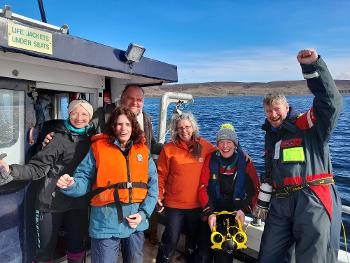Herring spawn found on maerly gravel ridges to the northwest of Loch Gairloch
Posted: Wednesday 13 March, 2024 @ 11:06:25

(illustrated report can be found here)
Herring have always been of much interest to communities in Wester Ross. Until the 1970s, they were of economic importance, providing local employment and a source of healthy food. Ullapool and Gairloch were major ports for landings of herring from the Minch fishery.
Herring were also a keystone species within the coastal ecosystem, providing food (as larvae, fry, part of the ‘whitebait’ and adult fish) for many other fish species including wild salmon and sea trout, for many birds; and for seals, whales and dolphins.
For the past 14 years or so, the Wester Ross Fisheries Trust has been supporting investigations to learn more about the herring which spawn in nearby coastal waters, firstly through a series of recorded conversations with former herring fishermen, and more recently by learning more about the timing, places and habitats where herring spawn.
Unlike many other commercial sea fish, herring spawn on the seabed. Herring eggs can form a layer, several eggs deep; they hatch after only two or three weeks and the tiny herring larvae drift away in the plankton. See https://www.wrft.org.uk/files/WesterRossHerringPoster19June2019reworked.pdf
In March 2018 and March 2019, herring spawn was found to the south of Loch Gairloch on maerl gravel to the West of South Erradale and Red Point. In 2019, the spawning event was recorded by cameraman, the late Andy Jackson, and shown on BBC Blue Planet UK and BBC Springwatch.
The herring that spawn in the spring around Wester Ross are genetically different from the autumn spawning herring which form the bulk of the North Sea herring stocks. West of Scotland spring spawning herring have been shown by geneticists working for ICES to be more closely related to Norwegian spring spawning herring than to North Sea herring.
To learn more about spring spawning herring, several people in the Wester Ross area including Peter Cunningham, biologist at Wester Ross Fisheries Trust, have been keeping their eyes open for signs of shoals of herring coming in to spawn; with support from the West of Scotland Herring Hunt Project.
The first signs of shoals approaching were seen in mid-February with sightings of gannets to the northwest of Loch Gairloch.
On the 25th of February unusually large pods of porpoises (up to 80+) were seen within 2km of the shore to the west of Peterburn near Gairloch; a pod of orca, known to travel between Iceland and Scotland, was seen just a few km offshore.
By the 9th March, the number of gannets that could be seen between Peterburn and Melvaig (to northwest of Gairloch) had increased to over 100, with many diving in where porpoises and seals were surfacing. Many other seabirds could be seen on the water nearby. A minke whale was seen on 7th and again on 9th March, close to the focus of activity.
On Sunday 10th March, areas of turquoise cloudier water could be seen from the shore, about 2km offshore, between Peterburn and Melvaig, indicative of herring spawning. The lighter water feature can be seen on a satellite photograph taken the same day when the sky was clear (https://apps.sentinel-hub.com/eo-browser).
To confirm that spawning had taken place, a team of local herring enthusiasts set off yesterday (12th March 2024) with Ian McWhinney of Dry Island Safaris to look for herring eggs on the seabed with underwater cameras including an ROV [Remote Operating Vehicle] belonging to the Little Loch Broom Marine Life survey group, operated by Sue Pomeroy and Fiona Mackenzie. The sea was calm, and conditions were ideal for our survey. Steve Truluck helped with navigation and recording associated cetacean activity.
Herring eggs were recorded on video about 2km from the shore to the west of Aultgrishan and to west of Peterburn, in water about 20m deep. The eggs were several layers deep on top of maerly gravel ridges. The gravel ridges are formed during big northerly swell conditions associated with a big storm, when the waves are big enough to winnow away the finer material and to sort and clean the gravel.
Some of the eggs stuck to the ROV; so a small sample of eggs has been preserved for future study by geneticists to learn more about our local populations.
The eggs on the seabed are expected to hatch after about two weeks. There may be hundreds of tonnes of them!
After they hatch, the herring larvae drift away in the plankton and provide food for sandeels, which in turn support many bird species including usually dozens of great-northern divers (common loons) which gather in April and early May each year close to the shore to the west of Melvaig, prior to migration to breeding lakes in Iceland, Greenland and beyond. Sandeels also attract Minke whales and other cetaceans in April and May.
For support with the survey, thank you to Sue Pomeroy and Fiona MacKenzie of Little Loch Broom Marine Life, Alice Walker (on holiday from Bedford Institute of Oceanography), Steve Truluck (Steve Truluck at Sea), Jezebel Schmid, Dry Island Shellfish; Iain Graham for use of pontoon at Badachro; Phil Taylor of Open Seas for forwarding on a satellite image; to Wester Ross Fisheries Trust and Prof Karen Diele and Dr Michelle Frost of West of Scotland Herring Hunt for support; and to Gairloch and Loch Ewe Wildlife Sightings facebook page, Hebrides and NW Scotland Cetaceans Sightings facebook pages and HWDT whaletrack for sharing information about observations of wildlife associated with shoals of herring. For help with observations over possible herring spawning areas and eDNA sample collection and general enthusiastic support, thank you to volunteers Dr Shraveena Venkatesh and Roger Ward.
An illustrated report with further details can be found here.
Further back ground information about herring spawning in Wester Ross can be found here:
https://www.wrft.org.uk/news/newsitem.cfm?id=103
https://www.wrft.org.uk/news/newsitem.cfm?id=205
https://www.wrft.org.uk/files/SpingSpawningHerring2018.pdf
https://www.wrft.org.uk/news/newsitem.cfm?id=221
https://www.wrft.org.uk/news/newsitem.cfm?id=224